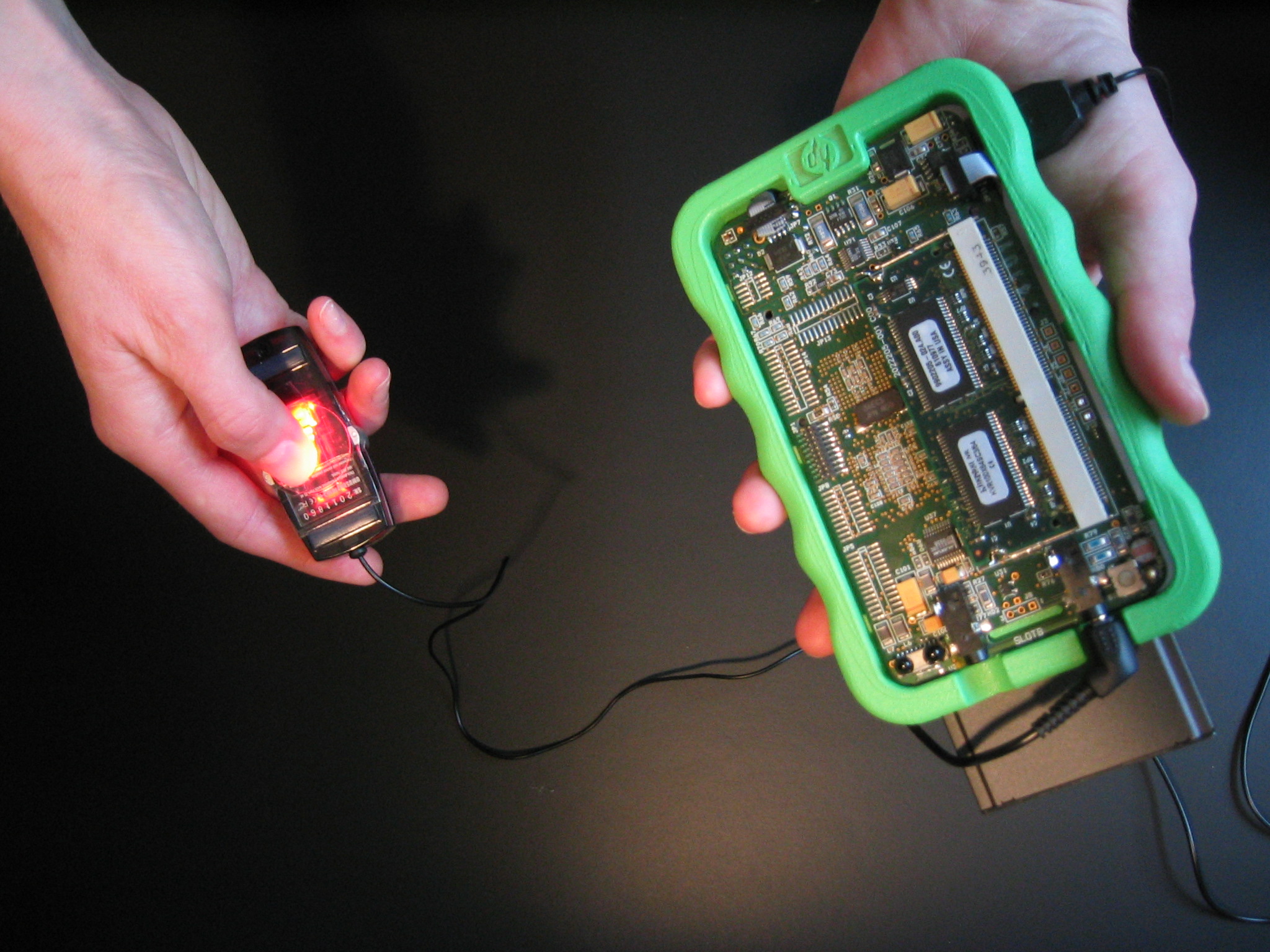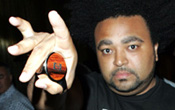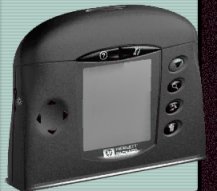IT Technologies, and the
kind of things you can do!
My professorship at the KTH is in IT product
development, which is an area that I enormously enjoy working
in. I received a Ph.D. in Bioengineering from
the
University of Utah in 1983, and joined Hewlett Packard Labs in 1984
after a year as a visiting faculty member in the University of Utah
Electrical Engineering department. Working at a company like Hewlett
Packard was a great way to not only learn from some of the best
engineers in the world, but it also gave me a chance to see how
technology goes from being an idea to real technology and finally
developed into a product.
While I was at Hewlett Packard Laboratories,
I was involved in a large number of different technology research
areas. My most recent work areas have been in
new
personal devices that exploit both the Internet,
and context awareness. One nic e thing about having a
Bioengineering background is that the role of sensors in human systems
form a natural input to future service based computing
architectures.
e thing about having a
Bioengineering background is that the role of sensors in human systems
form a natural input to future service based computing
architectures. The SmartBadge architecture series has been a
central platform for a
number of projects and experiments in context aware computing, mobile
media devices and low power systems. A number of interesting
platforms and systems have spun off from this work, including new kinds
of user interfaces based on sensors, security devices for identity
management and media enhanced communication. The last version of
the SmartBadge, shown in the photo on the far left, was
especially
fun as it supported multiple radios for communication, ran Linux, had
USB host ability, and had a number of hooks to make it easy to measure
the power consumption of the various subsections, such as the radios,
memory system or processor core. The SmartBadge shown is being
used in the original prototype of a very interesting project that was
called the DJammer
interactive MP3 architacture. The DJammer allow people to
interact with music streams by performing time shifting, or
'scratching' in the same way a professional DJ does. Because it
is wireless, it allows the resulting sound to be shared with
others. The picture next to the SmartBadge shows a professional
DJ (DJ Gavin
O'Conner) using the final version of the DJammer. He is actually
scratching on a sound track by moving his hands in mid air in a very
similar way that he would move his hands on a turntable. The
sensors used to detect his hand motion are contained in the metal
handpiece which serves as the entire user interface, and is an
example of a really beautiful mechanical design. Projects like the
DJammer are great to do as they show examples of the role of sensors
and sensor
support infrastructure in future consumer devices. They also show
how media can really be used to
communicate, inform and cause delight. I think the term "delight"
is a good
measure of consumer product success, and should be included along with
volume and profit.
The SmartBadge architecture series has been a
central platform for a
number of projects and experiments in context aware computing, mobile
media devices and low power systems. A number of interesting
platforms and systems have spun off from this work, including new kinds
of user interfaces based on sensors, security devices for identity
management and media enhanced communication. The last version of
the SmartBadge, shown in the photo on the far left, was
especially
fun as it supported multiple radios for communication, ran Linux, had
USB host ability, and had a number of hooks to make it easy to measure
the power consumption of the various subsections, such as the radios,
memory system or processor core. The SmartBadge shown is being
used in the original prototype of a very interesting project that was
called the DJammer
interactive MP3 architacture. The DJammer allow people to
interact with music streams by performing time shifting, or
'scratching' in the same way a professional DJ does. Because it
is wireless, it allows the resulting sound to be shared with
others. The picture next to the SmartBadge shows a professional
DJ (DJ Gavin
O'Conner) using the final version of the DJammer. He is actually
scratching on a sound track by moving his hands in mid air in a very
similar way that he would move his hands on a turntable. The
sensors used to detect his hand motion are contained in the metal
handpiece which serves as the entire user interface, and is an
example of a really beautiful mechanical design. Projects like the
DJammer are great to do as they show examples of the role of sensors
and sensor
support infrastructure in future consumer devices. They also show
how media can really be used to
communicate, inform and cause delight. I think the term "delight"
is a good
measure of consumer product success, and should be included along with
volume and profit.
Other technology areas I've worked in have
been
in new imaging devices. One of the coolest systems that has come
out of HP labs
was the Capshare handheld
document scanner shown over on the
right. The name Capshare is a contraction of the words Capture
and Share, but the internal
code names for the device were "Swipe" and later on "Zorro", and were
much more
evocative of how it was used than the product name. The basic
idea was a standalone handheld
device to scan in any document or other artifact on a flat surface at a
resolution of 300 dots per inch
using no moving parts and completely
natural hand and arm motion. To use no moving parts was a
challenge in itself, but using natural hand and arm motion meant that
the images could be very spatially distorted due to highly curved
motion trajectories. It also had to work successfully at a
velocity of up to 1 mile per hour over the surface being scanned, and
had to fit in your shirt pocket. I worked with some of the best
engineers and
computer scientists in HP on this project. Capshares are now
collector's items and you can only find them on ebay, but much of the
basic technology that came out of the Swipe project can be found in
other devices today.
of HP labs
was the Capshare handheld
document scanner shown over on the
right. The name Capshare is a contraction of the words Capture
and Share, but the internal
code names for the device were "Swipe" and later on "Zorro", and were
much more
evocative of how it was used than the product name. The basic
idea was a standalone handheld
device to scan in any document or other artifact on a flat surface at a
resolution of 300 dots per inch
using no moving parts and completely
natural hand and arm motion. To use no moving parts was a
challenge in itself, but using natural hand and arm motion meant that
the images could be very spatially distorted due to highly curved
motion trajectories. It also had to work successfully at a
velocity of up to 1 mile per hour over the surface being scanned, and
had to fit in your shirt pocket. I worked with some of the best
engineers and
computer scientists in HP on this project. Capshares are now
collector's items and you can only find them on ebay, but much of the
basic technology that came out of the Swipe project can be found in
other devices today.
Communication infrastructure technologies are
also areas I've done research in. One of the visions shared by a
number of researchers in HP labs has been the use of video as a
communication modality, especially in emerging wireless LAN
systems. In early work at HP labs we looked at how 3D graphics
and video could be composited and sent over a wireless channel.
This work gave rise to the MINT Wireless Mobile Internet Router, which
was work done with the KTH. A lot of research was done in
multiprocessor systems
to support algorithms for 3D graphics rendering and solid
modeling. As is still the case today, one can never really have
enough performance in graphics systems. Some of my current
research in communication infrastructure is centered around how to
aggregate multiple devices into forms that applications can discover
and use as if the aggregation were a single functional device.
My vita
gives details about some of the
systems that have been designed in these areas, plus pointers to
publications and
patents that have come out of this work. My favorite patent is
the one titled Method and Device for
Tracking Relative Movement by Correlating Signals From an Array of
Photoelements. This is an all optical motion sensor that
was intended for use as the 2D surface navigator in the Swipe hand held
image
scanner. The technology in it gave rise to all the sensors used
in today's optical computer mice.
I'm always ready to talk about technology,
research ideas, or
what life is like in a large industrial research lab. Come by and
visit. My
office is in Electrum 1, 3rd floor, elevator C. Go into
Wireless@KTH and then to room 6345, or send me email at msmith #@#
kth.se.
 e thing about having a
Bioengineering background is that the role of sensors in human systems
form a natural input to future service based computing
architectures.
e thing about having a
Bioengineering background is that the role of sensors in human systems
form a natural input to future service based computing
architectures. The SmartBadge architecture series has been a
central platform for a
number of projects and experiments in context aware computing, mobile
media devices and low power systems. A number of interesting
platforms and systems have spun off from this work, including new kinds
of user interfaces based on sensors, security devices for identity
management and media enhanced communication. The last version of
the SmartBadge, shown in the photo on the far left, was
especially
fun as it supported multiple radios for communication, ran Linux, had
USB host ability, and had a number of hooks to make it easy to measure
the power consumption of the various subsections, such as the radios,
memory system or processor core. The SmartBadge shown is being
used in the original prototype of a very interesting project that was
called the DJammer
interactive MP3 architacture. The DJammer allow people to
interact with music streams by performing time shifting, or
'scratching' in the same way a professional DJ does. Because it
is wireless, it allows the resulting sound to be shared with
others. The picture next to the SmartBadge shows a professional
DJ (DJ Gavin
O'Conner) using the final version of the DJammer. He is actually
scratching on a sound track by moving his hands in mid air in a very
similar way that he would move his hands on a turntable. The
sensors used to detect his hand motion are contained in the metal
handpiece which serves as the entire user interface, and is an
example of a really beautiful mechanical design. Projects like the
DJammer are great to do as they show examples of the role of sensors
and sensor
support infrastructure in future consumer devices. They also show
how media can really be used to
communicate, inform and cause delight. I think the term "delight"
is a good
measure of consumer product success, and should be included along with
volume and profit.
The SmartBadge architecture series has been a
central platform for a
number of projects and experiments in context aware computing, mobile
media devices and low power systems. A number of interesting
platforms and systems have spun off from this work, including new kinds
of user interfaces based on sensors, security devices for identity
management and media enhanced communication. The last version of
the SmartBadge, shown in the photo on the far left, was
especially
fun as it supported multiple radios for communication, ran Linux, had
USB host ability, and had a number of hooks to make it easy to measure
the power consumption of the various subsections, such as the radios,
memory system or processor core. The SmartBadge shown is being
used in the original prototype of a very interesting project that was
called the DJammer
interactive MP3 architacture. The DJammer allow people to
interact with music streams by performing time shifting, or
'scratching' in the same way a professional DJ does. Because it
is wireless, it allows the resulting sound to be shared with
others. The picture next to the SmartBadge shows a professional
DJ (DJ Gavin
O'Conner) using the final version of the DJammer. He is actually
scratching on a sound track by moving his hands in mid air in a very
similar way that he would move his hands on a turntable. The
sensors used to detect his hand motion are contained in the metal
handpiece which serves as the entire user interface, and is an
example of a really beautiful mechanical design. Projects like the
DJammer are great to do as they show examples of the role of sensors
and sensor
support infrastructure in future consumer devices. They also show
how media can really be used to
communicate, inform and cause delight. I think the term "delight"
is a good
measure of consumer product success, and should be included along with
volume and profit. of HP labs
was the Capshare handheld
document scanner shown over on the
right. The name Capshare is a contraction of the words Capture
and Share, but the internal
code names for the device were "Swipe" and later on "Zorro", and were
much more
evocative of how it was used than the product name. The basic
idea was a standalone handheld
device to scan in any document or other artifact on a flat surface at a
resolution of 300 dots per inch
using no moving parts and completely
natural hand and arm motion. To use no moving parts was a
challenge in itself, but using natural hand and arm motion meant that
the images could be very spatially distorted due to highly curved
motion trajectories. It also had to work successfully at a
velocity of up to 1 mile per hour over the surface being scanned, and
had to fit in your shirt pocket. I worked with some of the best
engineers and
computer scientists in HP on this project. Capshares are now
collector's items and you can only find them on ebay, but much of the
basic technology that came out of the Swipe project can be found in
other devices today.
of HP labs
was the Capshare handheld
document scanner shown over on the
right. The name Capshare is a contraction of the words Capture
and Share, but the internal
code names for the device were "Swipe" and later on "Zorro", and were
much more
evocative of how it was used than the product name. The basic
idea was a standalone handheld
device to scan in any document or other artifact on a flat surface at a
resolution of 300 dots per inch
using no moving parts and completely
natural hand and arm motion. To use no moving parts was a
challenge in itself, but using natural hand and arm motion meant that
the images could be very spatially distorted due to highly curved
motion trajectories. It also had to work successfully at a
velocity of up to 1 mile per hour over the surface being scanned, and
had to fit in your shirt pocket. I worked with some of the best
engineers and
computer scientists in HP on this project. Capshares are now
collector's items and you can only find them on ebay, but much of the
basic technology that came out of the Swipe project can be found in
other devices today.